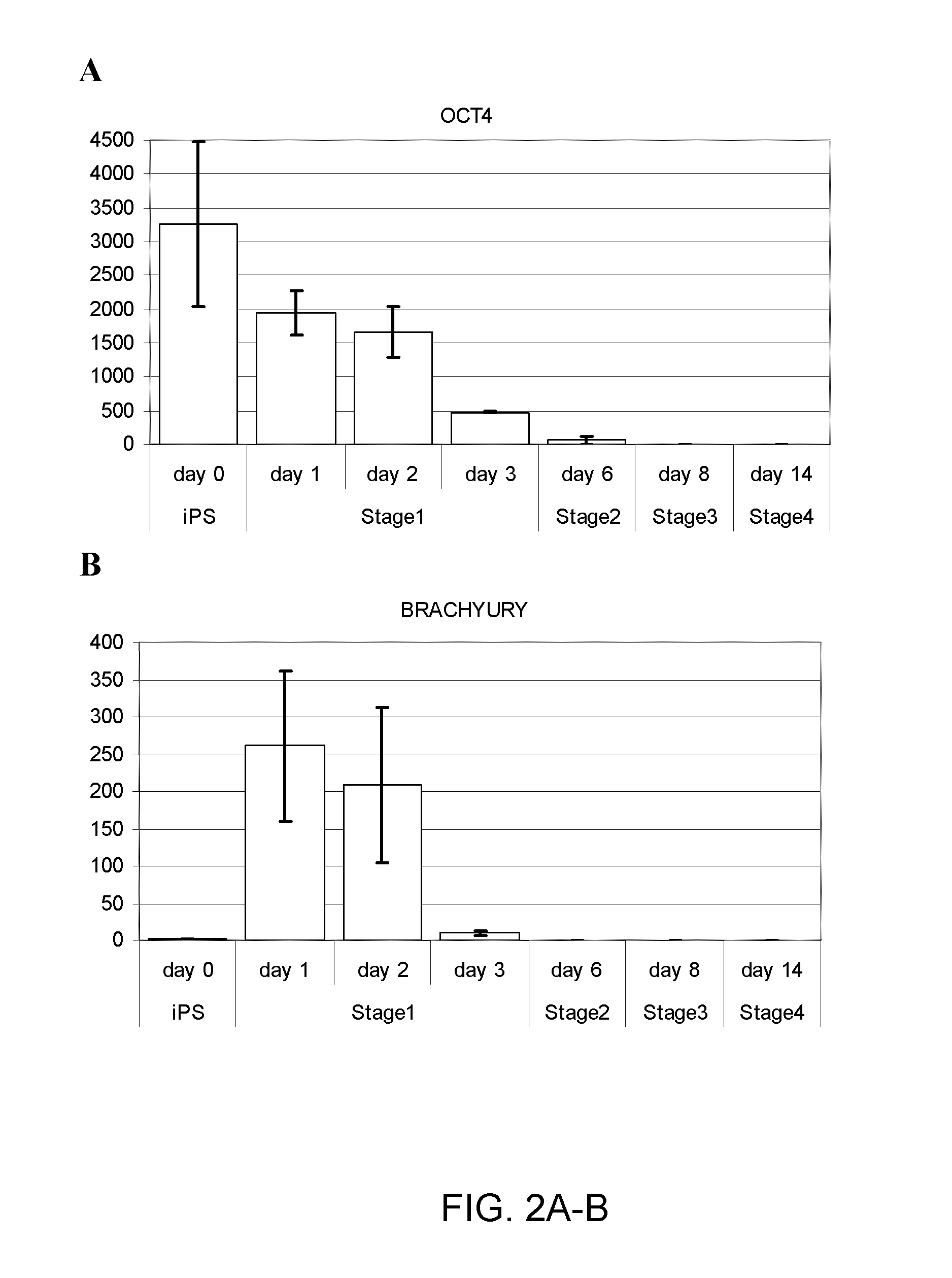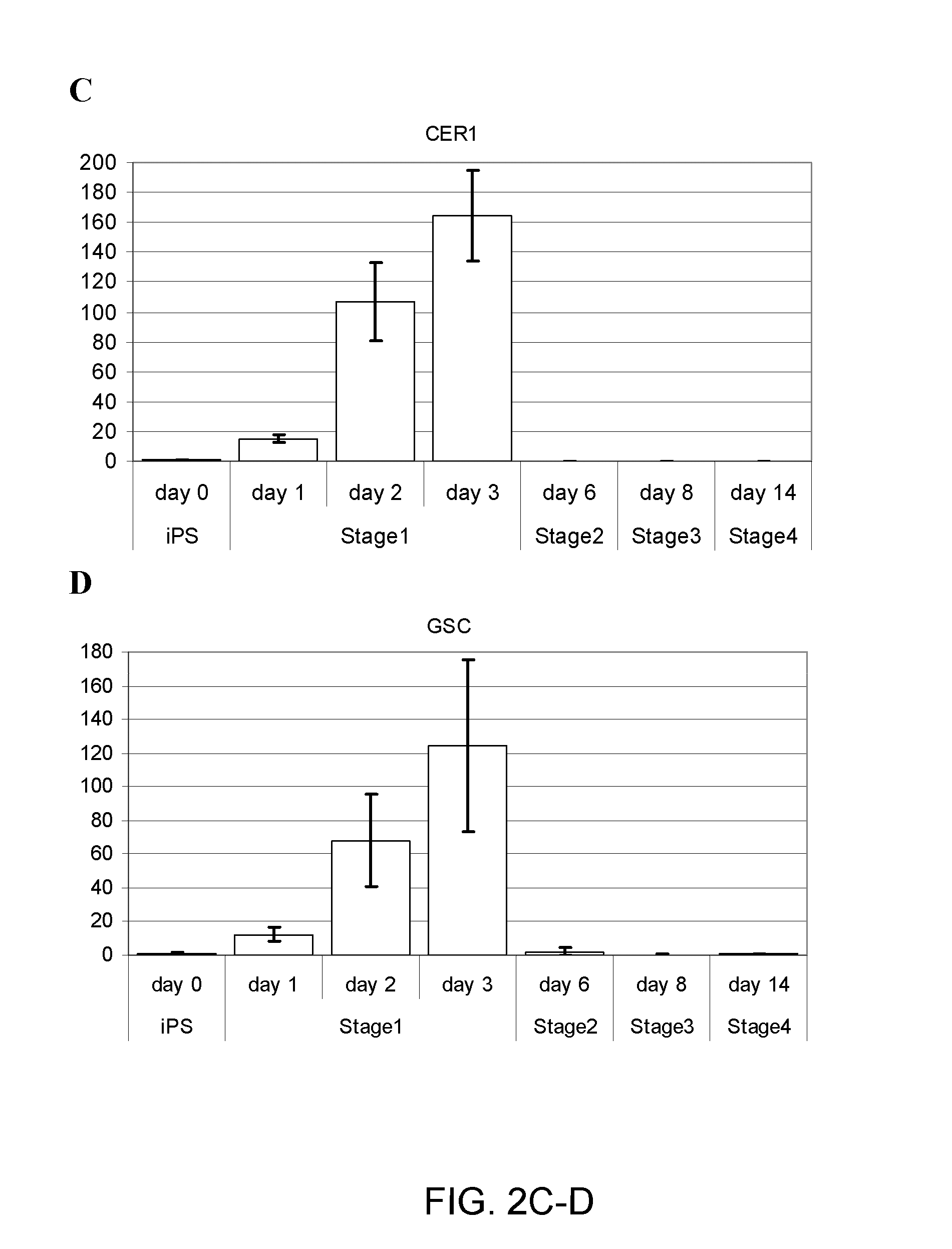Cell compositions derived from dedifferentiated reprogrammed cells
a cell composition and reprogramming technology, applied in the field of cell compositions derived from induced pluripotent stem cells, can solve the problem that the differentiation method of ips cells has not been demonstrated
- Summary
- Abstract
- Description
- Claims
- Application Information
AI Technical Summary
Benefits of technology
Problems solved by technology
Method used
Image
Examples
example 1
Differentiation of Human iPS Cells to Pancreatic Progenitors and Endocrine Cells Via Definitive Endoderm and Endoderm Intermediates
[0235]Human induced pluripotent stem (iPS) cells were differentiated in suspension aggregates using a four (4) stage procedure over the course of about 2 weeks (or 14 days) to generate a population of pancreatic cell types including pancreatic progenitors, endocrine progenitors and hormone expressing endocrine cells. Human iPS cell lines employed herein were provided by S. Yamanaka, Kyoto University, Japan and Cellular Dynamics International, Inc. (CDI).
[0236]The iPS cells described herein were first provided by Shinja Yamanaka and later by CDI. Undifferentiated iPS cells were grown on mitotically inactivated mouse embryo fibroblasts or preferably feeder-free (no fibroblast feeder cell layer) in DMEM / F12 containing 20% Knockout serum replacement. Differentiation was initiated by dissociating the undifferentiated iPS cells to single cells using accutase, ...
example 2
Rho-Kinase Inhibitors Promote Growth, Survival, Proliferation and Cell-Cell Adhesion of IPS Cells
[0244]Methods for differentiating various hES and iPS cell lines are substantially as described herein and in Example 1. In addition to the culture conditions as described for Stages 1, 2, 3, 4 and 5, apoptotic inhibitor and / or Rho-kinase or ROCK inhibitor was added to the culture media to enhance and promote growth, survival, proliferation and cell-cell adhesion during differentiation. Typically about 10 μM of a Rho-kinase inhibitor, for example, Y-27632 was added to the cell cultures at each of the stages. Alternatively, a Rho-kinase inhibitor was added to at least Stages 1 and 2 and stages 4 and 5, or any combination thereof. The morphology and gene marker expression profiles of the differentiated iPS suspension (aggregates) cell cultures are substantially similar to that of suspension cell cultures derived from hES cells.
[0245]FIGS. 3 and 4 show immunocytochemistry (ICC) of iPS cell ...
example 3
Encapsulation of IPS-Derived Pancreatic Progenitors
[0246]To date, methods for production of IPS cells and sources for production of IPS cells have been reported. However, there is no sufficient description of differentiating any iPS cell to any functioning differentiated cell for potential use in a cell therapy to treat a particular disease, for example, diabetes.
[0247]To determine whether the Stage 4 PDX1-positive pancreatic endoderm or pancreatic progenitor cell cultures derived from human iPS cells were fully capable of developing and maturing in vivo to glucose sensitive insulin secreting cells, the pancreatic progenitor populations substantially as described in Examples 1 and 2 were loaded into macro-encapsulating devices substantially similar to that described in U.S. application Ser. No. 12 / 618,659, entitled ENCAPSULATION OF PANCREATIC LINEAGE CELLS DERIVED FROM HUMAN PLURIPOTENT STEM CELLS, filed Nov. 13, 2009; and U.S. Pat. Nos. 7,534,608 and 7,695,965 entitled METHODS OF P...
PUM
| Property | Measurement | Unit |
|---|---|---|
| size | aaaaa | aaaaa |
| size | aaaaa | aaaaa |
| size | aaaaa | aaaaa |
Abstract
Description
Claims
Application Information
 Login to View More
Login to View More - R&D
- Intellectual Property
- Life Sciences
- Materials
- Tech Scout
- Unparalleled Data Quality
- Higher Quality Content
- 60% Fewer Hallucinations
Browse by: Latest US Patents, China's latest patents, Technical Efficacy Thesaurus, Application Domain, Technology Topic, Popular Technical Reports.
© 2025 PatSnap. All rights reserved.Legal|Privacy policy|Modern Slavery Act Transparency Statement|Sitemap|About US| Contact US: help@patsnap.com



